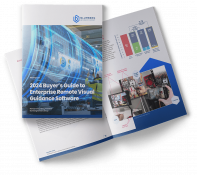Help Lightning Blog
Monstrous Pictures of Whales and Merged Reality
On Whales
The famous Ishmael of Melville’s Moby Dick struggles to share the true form and nature of whales with us (This is about merged reality; I promise!): “For all these reasons, then, any way you may look at it, you must needs conclude that the great leviathan is that one creature in the world which must remain unpainted to the last. True, one portrait may hit the mark much nearer than another, but none can hit it with any very considerable degree of exactness. So there is no earthly way of finding out precisely what the whale really looks like. And the only mode in which you can derive even a tolerable idea of his living contour, is by going a-whaling yourself; but by so doing, you run no small risk of being eternally stove and sunk by him.”
What do whales have to do with virtual reality?
Emerging technologies like virtual and augmented reality (VR/AR) are described in the tech media with a confusing mishmash of categories that make it nearly impossible for readers to know the true nature of these modern technology leviathans. At Help Lightning, we use these categories to describe our own products. So, let’s try to figure out what the difference between all these technologies are, and where Help Lightning fits in.
Virtual Reality vs. Augmented Reality
This one is perhaps the easiest to define. VR implies immersing the user into a completely fabricated world. The user perceives visual and audio stimuli that is almost entirely virtual (that is, fabricated) These stimuli generally do not represent the real world in which the user is immediately present. Think of movies like Avatar and Ready Player One, as well as products like Oculus Prime. AR implies taking visual or aural information from the real world, and sprinkling digital information within or over the base information streams. Think of the first-person view of the T1000 series in Terminator or the alien’s infrared, computer-enhanced perspective in Predator. Products representative of this category would include Google Glass, as well as products from companies such as Vuzix and RealWare. Some apps also qualify as AR. Classic examples would include Pokemon Go, IKEA Place, and Google Translate.
“Name It and Claim It” Mixed Reality
Microsoft has primarily defined and promoted this category to describe the experience for their Hololens. Mixed Reality distinguishes itself as a more complete AR experience than is possible with smart devices. The design of Hololens allows it to project information anywhere within the user’s field-of-view. This is much larger than the comparably tiny window of a smartphone or tablet.
Beam Me Up, Merged Reality and Virtual Presence
We often use these categories to describe Help Lightning. Merged Reality generally refers to integrating the field of view of two different people, who may be separated by large distances. For example, an observing surgeon in Mumbai could insert her hands or tools into the view of another surgeon in London. The surgeon in Mumbai may say: “here, let me show you how to perform this procedure.” And they can, directly in the field of view of the London surgeon. Or, as we like to say around here: “merged reality is the next best thing to teleportation from Star Trek.”
Help Lightning’s Place in All This: Merged Reality
Now, which category should house Help Lightning? First, Help Lightning is the definitive example of merged reality and virtual presence for field service. Being first has its advantages. As Apple and Google release mobile devices with more powerful AR technology, we are introducing a new feature: telestration-on-field (ToF). With our ToF, users can draw freehand or drop arrows directly on objects in their field of view. Those telestrations will stay attached to the object, no matter how you move the device. ToF will be visible to all participants on the Help Lightning call. This increases the clarity and efficiency of communication for our users.
Poor Ishmael risked life and limb to discover the taxonomy of Cetacea. With Help Lightning, it would have been a cake walk for him! He might have assisted his comrades on the Pequot from the comfort of a warm inn in New Bedford over a pint and a steaming bowl of chowder.
To experience Merged reality first-hand, visit Help Lightning and request a free demonstration.
Written by Neal Evans, CTO, Help Lightning












